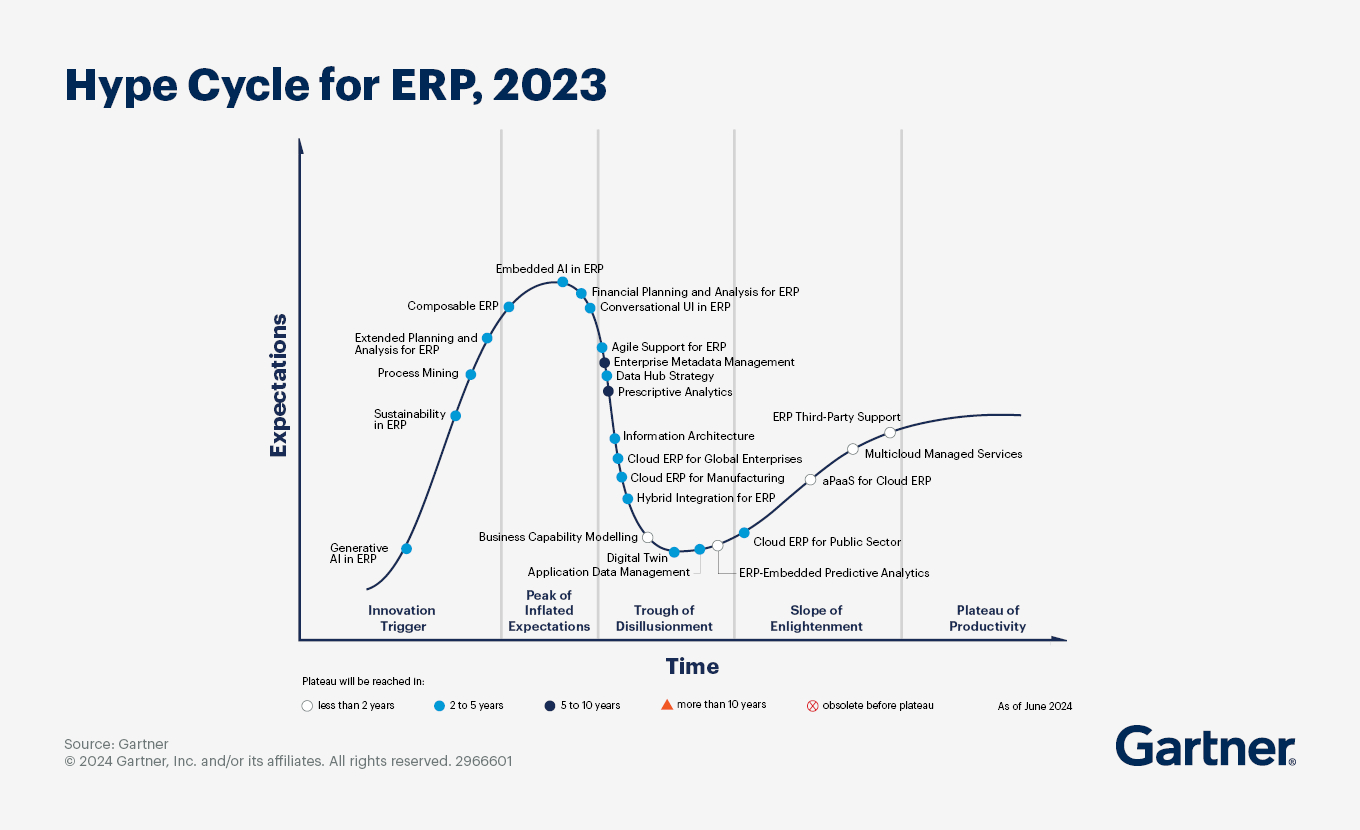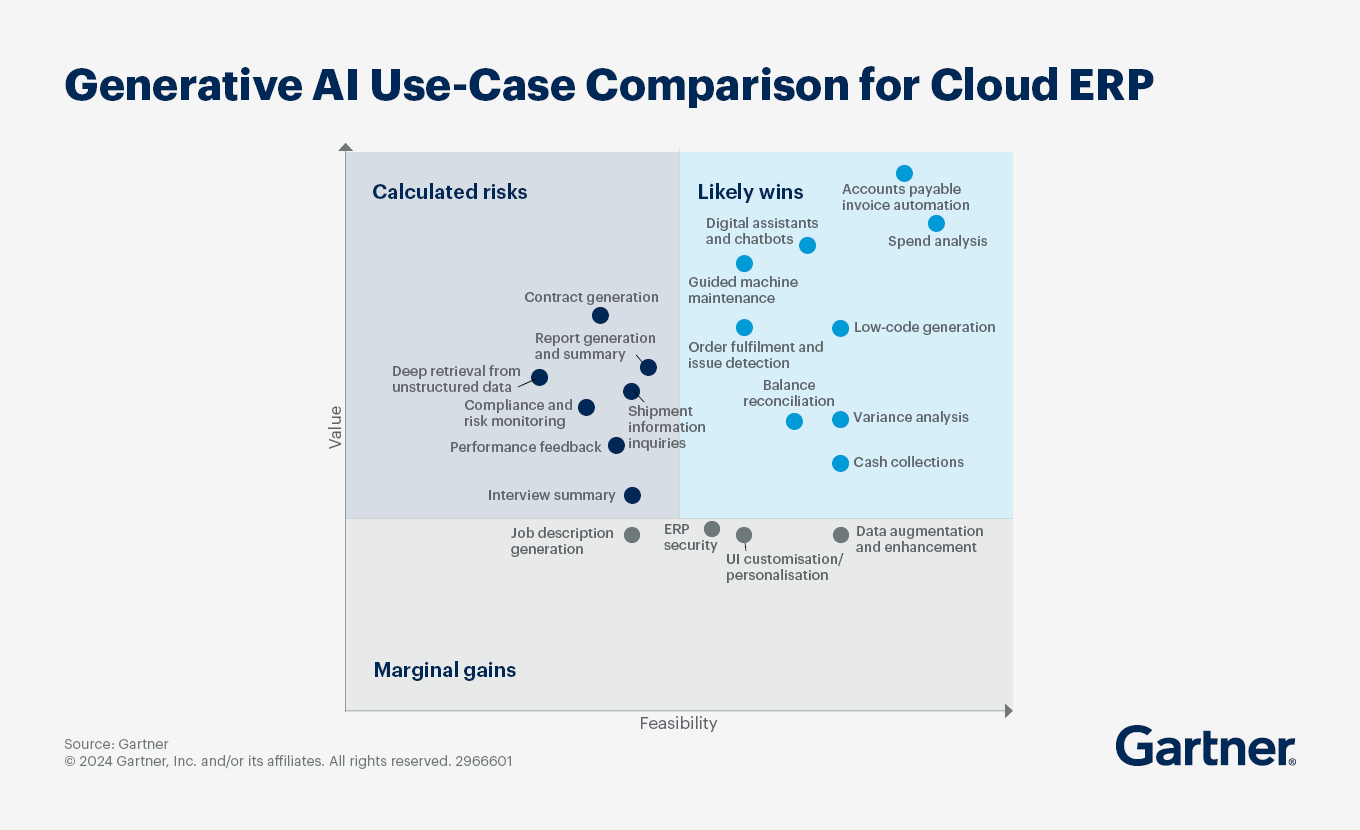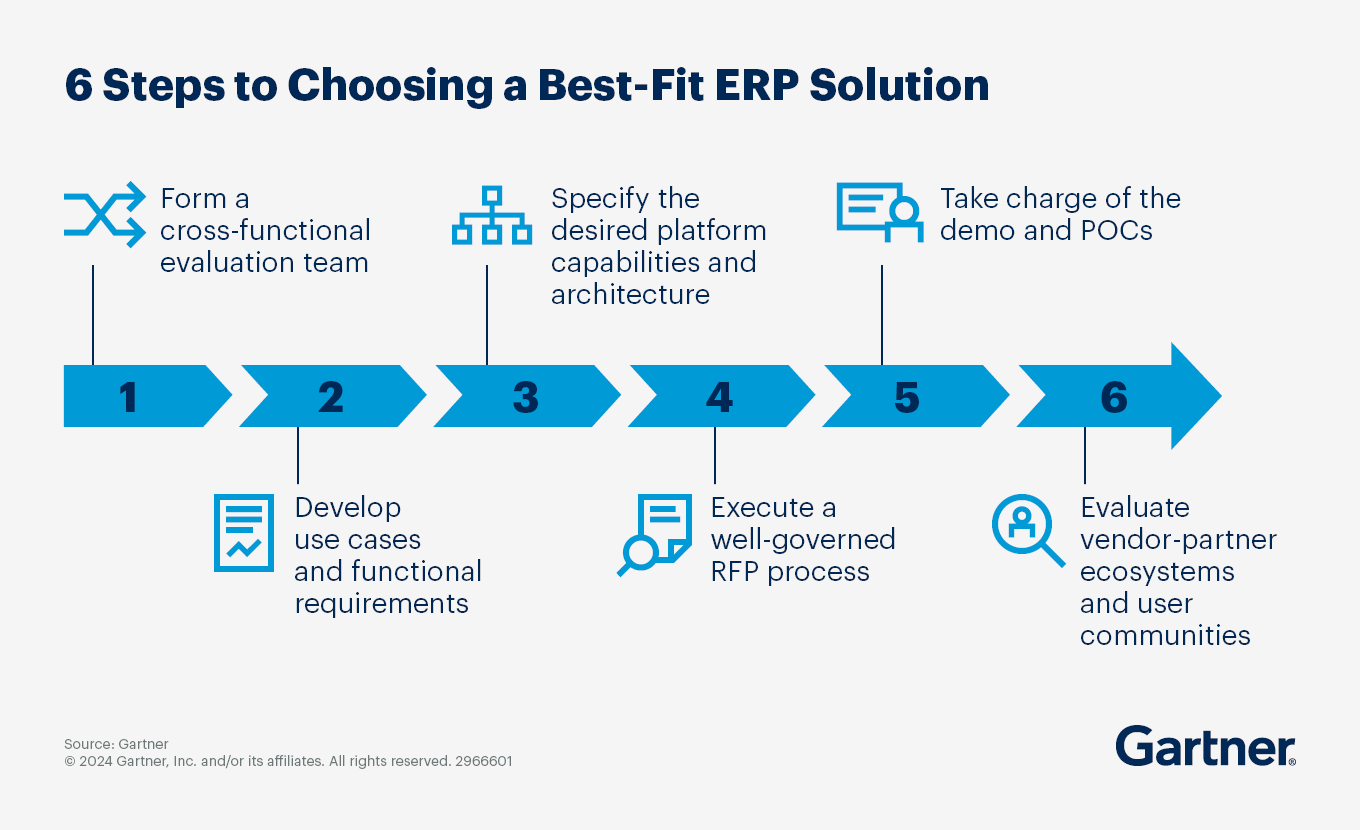ERP strategy must provide the flexibility your business needs and accommodate technology innovations like generative AI.
- Gartner client? Log in for personalized search results.
Enterprise Resource Planning to Optimise Operations
Design and evolve ERP to support continuous business value creation
Unparalleled negativity greets enterprise resource planning (ERP), with good reason: More than 70% of recently implemented ERP initiatives will fail to fully meet their original business use case goals. As many as 25% of these will fail catastrophically.
Aligning ERP initiatives to strategic goals is a top predictor of success. Download this research and learn how to:
create and promote your ERP strategy expectations from the start;
gain stakeholders’ support throughout the ERP initiative; and
turn end-user indifference into enthusiasm.
Target an ERP strategy that flexes with the business
The future of ERP will offer flexible, responsive capabilities, in part by including AI. Here is what you need to consider.
ERP Strategy
GenAI in ERP
Cloud ERP
ERP Implementation Risks
Replace monolithic legacy ERP with flexible capabilities
Enterprise resource planning applications automate and support multiple administrative and operational business processes, including line-of-business, customer-facing, administrative and the asset management aspects of an enterprise. Modernising them can be a challenge for many reasons, especially if you lack a documented ERP strategy, driven by business value.
Although ERP is considered a “strategic investment”, confusion has grown and alignment to business strategy has only weakened with the fast pace of ERP technology changes in recent years (e.g. SaaS, aPaaS and embedded AI capabilities).
Gartner research predicts widespread failure among ERP initiatives:
By 2027, more than 70% of recently implemented ERP initiatives will fail to fully meet their original business case goals.
As many as 25% of these will fail catastrophically.
And according to a recent survey, 75% of ERP strategies are not strongly aligned with overall business strategy, leading to confusion and lacklustre results.
This scenario makes it even more important to create a clear ERP strategy and set of principles to assess the fitness of new technologies to the projected business strategy outcomes, and answers the key question from business stakeholders of “what is in it for us?”
Replace monolithic legacy ERP with flexible capabilities
Done right, ERP provides the organisation with unrivalled visibility into and control of current operations, but it is more complicated than ever to deal with the agility that shifting business strategy requires when using monolithic application architectures.
This makes composable ERP, a strategic approach that targets gradual but continuous value achievement, increasingly important to ensure the business capabilities delivered in ERP applications are business enablers not inhibitors.
Composable ERP is an adaptive technology strategy that enables foundational, administrative and operational digital capabilities through which an enterprise can keep up with the pace of fast business change.
With this model, organisations can also more easily absorb the new technologies, including AI, generative AI, cloud ERP and composable ERP.
To prepare for radical changes in ERP technology:
adopt an ERP approach that enables an automated business strategy by challenging the old beliefs that led organisations to the current static and monolithic ERP architectures;
create a forward-looking architecture with a smart innovation strategy that balances AI-enabled capabilities with baseline investments; and
go beyond ERP by using automation and business process orchestration within ERP vendor upgrade and renovation initiatives.
As the classical focus on ERP shifts to a merger of broader enterprise planning, orchestration and automation journeys, the modernisation of legacy ERP approaches becomes even more of an imperative for organisations that want to benefit from the multiple possibilities that an intelligent application strategy could bring to them.
Gartner also advocates a composable approach when consolidating ERP projects as it creates new opportunities for common solutions across the enterprise, driving greater efficiency and business benefits within the operating structure while still delivering on cost savings.
Use the Gartner Hype Cycle™ for ERP to understand which technologies and frameworks can be used to underpin a composable approach.
Take a pragmatic approach to AI-enabled ERP as vendors pilot new solutions
Given the operational nature of ERP, generative AI (GenAI) has the potential to enhance and improve business outcomes and work with other AI technologies, such as predictive analytics or machine learning (ML), to automate process execution and thus create productivity efficiencies and data insights.
With GenAI, the ability to derive business value from novel combinations of content and data, ERP solutions and other sources should also become significantly easier.
ERP vendors are starting pilot use cases that drive GenAI and other AI and ML capabilities already in use. Examples of GenAI within ERP use cases include:
Human capital management (HCM): It can help derive position-description text for a newly open position based on the skills required for the role or derive text for documenting performance reviews.
Supply chain and customer order processes: It can use analytics to highlight supply chain issues that may impact existing open orders and autonomously produce an email or text message to customers.
Manufacturing: It can use analytics to predict shop floor equipment failure, which could prompt a repair work order along with GenAI-produced documentation on troubleshooting and repairing the equipment.
Finance: It can produce periodic reporting and narratives explaining variances.
Align AI uses with broader ERP strategy
Take a pragmatic position as you guide your organisation in assessing the opportunities and risks of GenAI. Before committing to solutions, make sure to:
develop and curate an ERP strategy that is directly connected to the overall enterprise strategy and goals. Ensure alignment between the adoption of GenAI goals and the enablement of any ERP SaaS, platform as a service (PaaS) or infrastructure as a service (IaaS);
- understand the data requirements to support credible insights into the GenAI mechanism under consideration. Ensure relevant and credible data is available (or insights will not be reliable);
assess ERP vendor road maps to understand how they are using existing AI technologies and planning to incorporate GenAI use cases into their solutions. Verify the benefits;
manage stakeholder expectations until your own experiences or credible case studies reveal the effectiveness and risks of GenAI evolution;
identify scenarios where the technology is not appropriate or permitted. This must include individual grants to access data inside the organisation;
establish who will decide and enforce a governance process. Determine the criteria for continuously evaluating whether ERP applications with AI capabilities will work to their satisfaction and produce trustful outcomes; and
determine cost models for different levels of anticipated adoption and usage to extrapolate potential ROI requirements. Ensure licensing, consumption or data egress charges are part of the evaluation.
How to select the best ERP cloud solutions for your business
When it comes to ERP, the goal of business domains was often to establish a “once and done” block of software, with sporadic upgrades done just before the current version is going out of support. The latest generations of cloud ERP SaaS products move away from this strategy.
Gartner expects cloud ERP SaaS vendors to deliver at least two major application updates per year. Vendors must install the updates to the production tenants; although, the customer may have some leeway around the activation of the new features. Composable businesses are consistently evaluating their processes and capabilities for improvement.
As organisations move ERP applications to the cloud, business areas take on more involvement in supporting ERP. This is most evident in the financial and HCM domains, and the ERP market can be difficult to navigate for these stakeholders.
Selecting a cloud ERP solution results in a multiyear commitment, and choosing the best-fit cloud ERP solution can consume a considerable amount of money, time and resources.
If planned poorly, your project will become protracted and exceed the budget, resulting in an ERP that is a poor fit for your organisation.
6 steps to identifying the best cloud ERP solution
When developing your vision for ERP in the broader context of a composable application strategy, keep in mind that you may need to make compromises when standardising on a suite. No single ERP suite vendor has best-in-class capabilities in all areas.
Many products offered by suite vendors are maturing quickly, becoming more stable and approaching parity with best-of-breed solutions.
After reviewing your overall business application strategy and ERP’s position within it, build the business case and take these steps to identify your best-fit solution.
Form an evaluation team by selecting functional, technical, line-of-business staff and end users.
Define and prioritise use cases and functional requirements by focussing on current and future needs. Doing so ensures that breadth- and depth-of-processing coverage are included in the evaluation.
Ensure the desired platform reference architecture and capabilities are specified by guaranteeing the underlying agility and flexibility are consistent with the business application strategy.
Execute a well-governed RFP process by analysing the ERP landscape and ensuring evaluation integrity and objectivity.
Control vendor demonstrations by constructing effective demo scripts that focus on meeting business objectives, delivering results and illustrating how users successfully interact with the cloud ERP solution.
Evaluate user communities and partner ecosystems by exposing the additional value they may contribute through the application life cycle.
Bring business and tech stakeholders on board to mitigate implementation risks
As a transformational initiative, ERP is often complex and affects many stakeholders. Implementation fails for a variety of reasons, most often lack of executive team commitment, or lack of understanding of the organisational change needed for success.
Among the other risks to ERP implementation:
Low end-user adoption. Users who are unaware of the rationale for ERP implementation and its impact on them will not be able to absorb workflow changes, resulting in an inefficient rollout. Example: ERP project teams that do not involve potential end users could miss early signs of errors and inefficiencies that will be uncovered once the ERP project is live.
Misalignment with business needs. ERP project scope that is highly customised based on current or near-term requirements will fail to keep up with changing business goals after implementation. Example: ERP applications that do not conform to the business’s changing KPIs will fail to deliver value and may have to be replaced entirely, resulting in higher costs.
Flawed project execution. Unclear division of responsibilities and poor communication of strategy hinder project execution, resulting in delays, scope deviation, budget overruns and reduced organisational impact. Example: Errors missed throughout the implementation process and only discovered after the system went live, leading to state investigations, settlements and rework costs.
Data risks:
Data governance and data integrity can be major roadblocks in ERP implementation. Example: Changing regulations around cross-border data transfers.
Data security. Lack of access management controls and poorly constructed data security governance frameworks make ERP applications susceptible to data breaches. Example: Unauthorised access to confidential data by employees.
Data integration. Integration of ERP applications with legacy systems may require costly middleware software solutions and can result in data inaccuracy, redundancy or loss. Example: Migration from legacy systems and non-ERP interfaces may result in data inaccuracy or loss.
IT systems risks. Outdated IT infrastructure, including hardware, software and network resources, may render the ERP investment obsolete. Example: Legacy infrastructure with outdated security and controls that fail to prevent data breaches.
Cloud migration risks. Transitioning from on-premises ERP to a cloud-based solution may result in delays, additional costs and security risks. Example: Public exposure of data, weak access credentials, weak security of APIs, cloud-based denial of service attacks and malicious cloud service provider intent.
Collaborating with business partners is key to mitigating ERP implementation risks
To improve the chances of a smooth ERP implementation or transformation, make sure to spend sufficient time expressing the opportunities to business partners in terms of outcomes they want.
Work with business stakeholders to:
define business-led ERP transformation and continuously realign the ERP strategy with the evolving digital transformation strategic playbook;
create value stories that match ERP capabilities to strategic initiatives, then express those capabilities in terms of business value; and
create multiple versions of value stories that speak to multiple stakeholders’ definitions of value.
Experience Chief Information Officer Head of IT conferences
Join your peers for the unveiling of the latest insights at the Gartner conferences.
Frequently asked questions on ERP
What is ERP in simple words?
Gartner defines enterprise resource planning (ERP) as the ability to deliver an integrated suite of business applications. ERP tools share a common process and data model covering broad and deep end-to-end processes like those found in finance, HR, distribution, manufacturing, service and the supply chain.
What is the main purpose of an ERP system?
ERP applications automate and support various business processes across industries, including administrative, operational and asset management. Although ERP deployment is complex and costly, it offers business benefits in four key areas: driving innovation, enhancing process efficiency, standardising processes and reducing IT costs. While the last two are easiest to measure, the first two often have the most significant impact on the enterprise.
Drive stronger performance on your mission-critical priorities.




